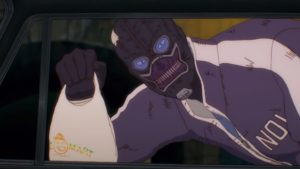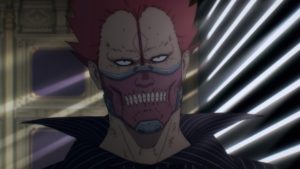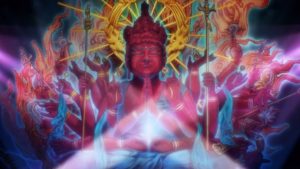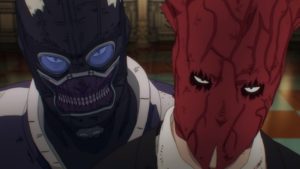A couple notes before we get started: I’ve only read the first volume of the Dorohedoro manga, which was covered by the anime’s first two episodes. As such, I won’t be making comparisons between the two versions, so if that’s what you’re looking for specifically, you’ll have to search elsewhere. If you’re a manga reader, the plus side of my TV-only viewership is that you can read someone’s unspoiled thoughts on the series’ nutty developments. Plus, this being an anime review, I can talk about color, animation, music, and voicework – though that sort of discussion might have to be tabled for the first couple posts while I try to wrap my brain around the show’s unique logic.
Also, I’m watching with [anon]’s subs, which read more smoothly to me than either of the currently available alternatives. Just in case anyone was wondering which version to download, there’s my two cents.
Right off the bat, no discussion of this show would be complete without mentioning its bangin’ opening theme. “Welcome to Chaos” is about the most fitting title it could possibly have received, given the boundary-pushing nature of both the song and its accompanying visuals. The wailing vocal performance that both opens and closes the track couldn’t be a more perfect harbinger of batshittery if it tried. There’s a fuzzy, atonal organ in the background that never lingers on one note for more than a split second, propelling the song forward in schizophrenic style. And the grungy lead guitar, of course, compliments the filthy look of Nikaido’s diner, which we see from all angles during the OP. Her joyous, occasionally unhinged expression while preparing the pork for her famous gyoza is the stickiest image on offer here, but it’s a close contest. Where else can you see a masked dog chasing an anthropomorphic cockroach through a kitchen that looks like a health inspector’s nightmare come to life?
Speaking of grime, this is the dirtiest, dingiest anime I’ve seen in recent years. Hole, the name of the city where the bulk of the action takes place, is a truly miserable place, dense with crumbling buildings and peeling paint. Exterior surfaces are caked with graffiti and rust, and the sky is consistently overcast, giving the setting a feeling of decay and hopelessness. Dystopias on this level are usually confined to the realm of theatrical animation, where backgrounds are given much more emphasis, but they were clearly a priority for Dorohedoro. If you want an explanation for the show’s terrific world design, look no further than Shinji Kimura’s role as art director, since the bulk of his work over the last 30 years has been on films (Tekkon Kinkreet chief among them). He was also responsible for crafting the New York-inspired streets of Kekkai Sensen, which possessed a similar level of detail to this series, even if they were marginally cleaner-looking. If there’s one person to whom the show’s presentation owes the largest debt, in my opinion, it’s Kimura.
Dorohedoro’s decomposing world is one of the anime’s main attractions for me, but it’s not as though the show is just panning shots of wretched-looking cityscapes. There’s an entirely original story taking place in the foreground – a story so violent and unpredictable that it’s hard to know how seriously we’re meant to take it. There’s plenty of darkly comic relief – the street punk who whines about his dislodged eyeball getting stepped on springs to mind. Still, the series’ main plot line (the war between Hole and a neighboring realm inhabited by sorcerers) is an inherently dramatic one. When you take that sort of drama and smear it with Dorohedoro’s brand of weirdness, the resulting Venn diagram would seem to contain very little overlap. Take the dinner scene led by En, a big shot sorcerer, for example. He and his guests all wear masks, they’re waited on by costumed servers, and they eat mushroom-based dishes made from the transfigured remains of his murder victims. During their meal, En is attacked by a pair of shapeshifting entertainers, who he transforms into more mushrooms by shooting black smoke from his mouth. Oh yeah, circus music also plays during the first half of the scene. Isn’t that degree of peculiarity counterproductive when trying to tell a long-form story?
Shockingly, no. Even though Dorohedoro hasn’t yet established clear rules for its world, it’s done something far more important by writing recognizable characters. Their faces might be obscured 80% of the time, but it’s not hard for me to see parts of myself in their dialogue and mannerisms. The opening scene of this week’s episode, where two cleanup killers in En’s organization sit in a car and eat convenience store food, left a strong impression on me for just that reason. They talk smack about their boss, argue about trash bag brands, and make offhand remarks about the taste of their meal. Even before they exit the car to carry out their mission, you get the sense that Shin is a job-weary veteran, while Noi is excited and eager to prove herself. They have a camaraderie that’s rooted in the violence and the absurdity of their profession, which is reflected in the way they speak to each other. During the dinner scene I mentioned previously, both of them disarm En’s would-be assassins by throwing silverware at their hands. Immediately afterwards, Shin criticizes his partner for using a fork rather than a readily available knife. The show doesn’t linger on the moment; it’s merely an extension of who he is.
There’s so much more to talk about regarding this episode, but I’m closing in on 1000 words, so I’m gonna call it here. Future posts won’t spend so much time on the OP or the show’s general art design, so I’ll be free to react to a wider array of plot points each week. Even so, the show’s sense of style is its trump card (CG models notwithstanding), so it’ll be easy to avoid Recap Syndrome while writing about it. Hopefully the fansubs keep flowing so I don’t have to pick up something else, because I’m quite enjoying it so far.





Let’s see if this comment goes through. Every time I try to comment on a post it gets blocked since the site address changed.
One of the things I especially enjoy about this series is that it is following the “show, don’t tell” style of storytelling. The first episode made us think that all magic users were evil, but in this episode we see Needle just chilling out at the bar. He even offers his services after being assaulted like it’s not a big deal. Same with Shin and Noi; we got to see who they are in short period of time without any exposition, and it felt natural.
Yeah, comments are wonky right now. It’s something we’ve looked into without much success, but we’re aware of the issue, at the very least. Glad you were able to break through this time.
Definitely agree that Dorohedoro unfolds at a nice pace, with a minimum of self-explanation. Between the two examples you provided, I much prefer the way we were introduced to Shin and Noi – people acting so blasé about nearly losing their lives is a tough sell. Even so, it adds another layer to the show’s universe: threats of violence are so common that people have accepted them as par for the course.
I barely have any idea what’s going on, but I like the grimy gyozas and giant women. 10 stars. I’ll be back for episode 3.